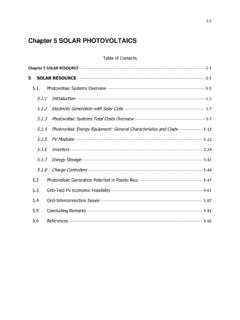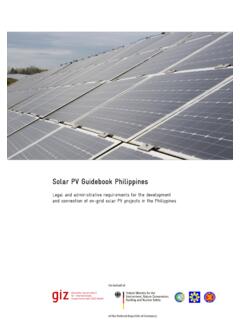Transcription of Training Manual for Engineers on Solar PV System
1 See discussions, stats, and author profiles for this publication at: Training Manual for Engineers on Solar PV. System TECHNICAL REPORT JULY 2011. DOI: 2 AUTHORS, INCLUDING: Shree Raj Shakya Tribhuvan University 17 PUBLICATIONS 30 CITATIONS. SEE PROFILE. Available from: Shree Raj Shakya Retrieved on: 23 August 2015. ALTERNATIVE energy PROMOTION CENTRE. (AEPC). energy SECTOR ASSISTANCE PROGRAMME. (ESAP). Training Manual For Engineers on Solar PV System July 2011. Government of Nepal Ministry of Environment, Science and Technology Alternative energy Promotion Center (AEPC). energy Sector Assistance Programme (ESAP). Khumaltar Height, Lalitpur Box: 14237, Kathmandu, Nepal Tel: +977-1-5539390, 5543044, 5539391.
2 Fax: +977-1-5539392. Email: Web site: Coordinated by Ram Prasad Dhital, Sr. energy Officer Madhusudhan Adhikari, Solar energy Component Manager Team of authors Prof. Dinesh Kumar Sharma, Dr. Team leader and PV Expert Er. Shree Raj Shakya, energy Expert Editing Team: Mr. Mukesh Ghimire energy Officer AEPC. Mr. Chaitanya P Chaudhary Program Officer AEPC/ESAP. Preface The Alternative energy Promotion Centre (AEPC) was established in 1996 as an apex government body to promote the use of renewable energy technologies to meet energy needs in rural areas of Nepal. With successful completion of the first phase of the energy Sector Assistance Programme (ESAP), AEPC has initiated second phase of the programme from March 2007 with support from Government of Denmark and the Government of Norway.
3 The support to Solar energy is one among the different programme components. Working for promotion of the PV technology among the rural population out of access to electricity, ESAP has been carrying out different trainings for capacity building of partner organizations. As a Training tool to use in Solar Design Engineers '. Training , a Manual has been developed with effort from experts and other concerned. This volume of Training Manual for Engineers on Solar PV System consist of technical details required for feasibility study, designing and implementation of institutional Solar Photovoltaic systems. The Manual is with adequate information and guidelines to be used in Training for Engineers working in Solar PV or with interest to work in the sector.
4 Authors' team of PV expert, Prof. Dr. Dinesh Kumar Sharma and energy expert, Engineer Shree Raja Shakya has put their significant effort for preparing this Manual . I would like to acknowledge their effort in this endeavour. I would like to thank SSP manager Mr. Madhusudhan Adhikari and Sr. energy officer Ram Pd Dhital for support while preparing this Manual and would like to thank AEPC energy officer Ghimire, SSP programmer officer Mr. Chaitanya P. Chaudhary for their support in this attempt. I further would like to acknowledge the support of all responding institution and individuals who provided the valuable information to complete this Manual . Dr. Narayan Prasad Chaulagain Executive Director Alternative energy Promotion Centre (AEPC).
5 Table of Contents Training Manual for Engineers on Solar PV System At a Glance Training Schedule 1. Skill Standards of CTEVT, Skill Testing/ Certification procedures 1. 2. Features and requirements for Skill Standard tests and certification procedures for Solar photovoltaic Design Engineer and Technicians 3. 3. History of development of Solar photovoltaic technology in Nepal 5. 4. Basics of Electrical Engineering 11. Electrical Power Supply System 12. Solar Photovoltaic Technology 17. 5. Fundamentals of Solar photovoltaic technology 27. Basic Principles of Photo-Voltaic Effect 28. Solar Cells 33. Solar Modules 43. Solar Array 51. 6. Components of a Solar photovoltaic System 57.
6 Batteries 58. Charge Controllers 73. Lamps and Other Loads 80. DC-AC Inverters 86. DC-DC Converters 90. Wiring and installation practices 92. 7. Solar home System (SHS) design and installation 95. Design of Solar Home System (SHS) 97. Installation of Solar Module 106. Installation of Charge Controller 109. Installation of Battery 110. Wiring of the Solar home System components 110. Lamp installation procedures 115. Switch installation procedures 117. Power socket installation procedures 118. Components assembly of Solar Home System 119. Installation of Solar home System components 123. 8. Repair and maintenance of components of Solar photovoltaic systems 125. Solar Module 127.
7 Battery 127. Charge Controller 131. Solar Lamp 141. DC-AC Inverter 144. DC-DC Converter 144. Demonstration of various components, their testing and repairing procedures 145. 9. Design aspects of large Solar photovoltaic systems (non-pumping applications) 149. Load calculations 151. Sizing of Module /Array 156. Sizing of Storage Battery 159. Sizing of Charge Controller 161. Sizing of Wire/ Cable 163. Sizing of Inverter 165. Sizing of DC-DC Converter 167. Installation Procedures, Safety and Protection 168. 10. Design aspects of water pumping systems 189. Introduction 191. Water Pumping System Configurations 193. Water Pumps 194. Motors 198. Integrated Pump/Motor Machines 200.
8 Power Conditioning Circuitry 203. Array Wiring and Mounting of Water Pumps 204. Water Pumping System Design 205. Installation Line Diagrams 214. Routine and Preventive Maintenance 217. Monitoring and Evaluation of Installed Water Pumps 218. 11. Socio techno Economic Feasibility Study 221. Introduction 222. Basic Principles of Feasibility Study 222. Technical Aspects of Feasibility Study 223. energy Demand Analysis 224. Financial Analysis 224. Sensitivity Analysis 234. Repayment Schedule 235. Cash Flow Analysis 236. Tables and Formula for Quick Reference 240. Suggested Format for Feasibility Study 244. References Technical Glossary Appendices: 1. Nepal Interim PV Quality Assurance 2.
9 Format for Feasibility Study of ISPS. 3. Solar Radiation in Different Parts of Nepal 4. Technical Catalogues of Various Solar PV Components Training Manual for Engineers on Solar PV System 1. Objective: To provide Training to the Engineers capable of working and willing to work on Solar Photovoltaic Systems. 2. Duration: 8 days (49 hours) + 1 day Field Visit 3. Minimum Qualification of trainee: Bachelor's degree in Engineering. 4. Minimum Qualification of trainer: Engineers or PV experts with good experience in design and installation of Solar Photovoltaic Systems. 5. Reference materials: a) Solar Photovoltaic System Design Manual for Solar Design Engineers , AEPC/ESAP.
10 B) Solar Electricity Technical Training Manual (Level 1), AEPC/ESAP. c) Solar Electricity Technical Training Manual (Level 2), AEPC/ESAP. d) Training Manual for Training of Solar technician trainers 6. Suggested course outline: i. Skill standards of CTEVT and skill testing/ certification procedure. ii. Features requirements of certification procedure for Solar PV Technician level-1. iii. Features requirements of certification procedure for Solar PV Technician level-2. iv. History and development of Solar photovoltaic in Nepal featuring history, installed capacity, users and promoting institutions, donors, future plans and programs. v. Basic of electrical engineering theory.









